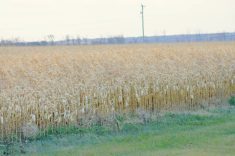John Gavloski is back on the hunt for European corn borer (ECB).
The provincial entomologist hopes to collect 50-100 larvae from Carman-area fields this year, part of a long-standing project to monitor resistance to Bt (Bacillus thuringiensis), a toxin-producing bacteria and the most commonly cited ECB management method.
Bt is either used as a spray, much like other pesticides, or through Bt varieties, genetically modified to produce the toxic proteins. Larvae feeding on Bt corn die in short order.
“It’s not a big study where I’m going to be having 20 different Manitoba fields or anything,” he said. “I usually like to collect from two to three fields, but if I hit the jackpot with a particular field and the other fields don’t have much, I’ll do all my collecting from that one field.”
Read Also

Manitoba canola industry has new frontiers
Canola oil is still the main priority for the sector, but canola meal is increasingly the subject of research looking for new markets and uses for the oilseed’s byproduct.
The researcher has put out the call for producers growing non-Bt corn and who have preferably not sprayed for the pest to participate in the study.
Once collected, larvae will be sent to Guelph, Ont., to be exposed to Bt corn in a controlled setting. Survival is then measured.
Pam de Rocquigny, general manager for the Manitoba Corn Growers Association, says the pest is a fluctuating concern for producers.
“It does vary and it tends to occur within pockets, almost, throughout the province in any given year,” she said. “Infestations can be quite variable from year to year, so in some areas they could have substantial issues whereas other areas you’ll really see littler or no damage.”
Central Manitoba reported high ECB populations in the previous three years, with levels rising above economic thresholds in both 2014 and 2015.
As its name suggests, the corn borer larvae buries into stalks, causing them to break easily.
“Another type of damage is ear drop where cobs fall to the ground,” Manitoba Agriculture states on its website. “The final type of damage may be the least obvious but can cause significant yield loss. By restricting nutrient flow in the plant, yield is affected by the production of smaller cobs.”
Pinhole damage has also been noted on the plant’s exterior and may be the first sign of infestation as the young larvae feed on the surface of the plant in the first days after hatching.
The pest overwinters in cornstalks and field residue before pupating and emerging as an adult moth in spring.
Monitoring resistance
Manitoba’s population shows no resistance at this time, Gavloski said.
The grain industry hopes to keep Manitoba’s resistance-free record. Experts have advised farmers to include “refuges,” sacrificial plants that do not produce Bt and provide limited habitat for the pests to lower resistance pressure.
“There’s always some people who aren’t complying, but I think for the most part people are aware that they need to have a refuge and most are doing it and nowadays a lot of the corn that people buy has what is called a blended refuge, where the susceptible variety is blended right in,” Gavloski said.
Manitoba Agriculture notes that in-season treatment is only effective during the first two larval instars, a window that closes within seven to 10 days of eggs hatching. After that, larvae tunnel into the safe haven of the cornstalk and will be unaffected by Bt sprayed on the surface of the plant.
In 2014, Bt varieties accounted for 42.9 per cent of grain corn acres and 15.1 per cent of silage corn. The next year, the Manitoba Agricultural Services Corporation reported that about 44.9 per cent of grain corn was a Bt variety, while silage acres dropped to 13.9 per cent.
That’s a jump from the 2011-13 era, when resistant grain corn acreages dropped to a 26.8 per cent low, but remains low compared to acres planted in the late 2000s. From 2007-10, an average 58.5 per cent of grain corn acres went to Bt varieties, peaking at 63.9 per cent in 2007.
Silage corn climbed from 10.8 per cent of acres in 2007 to over 17 per cent for the next five years, peaking in 2011, when Bt varieties made up 21.2 per cent of acres.
Producers wishing to participate in the study can contact Gavloski at 204-745-5668, by email at [email protected] or contact the Manitoba Corn Growers Association main office.




















